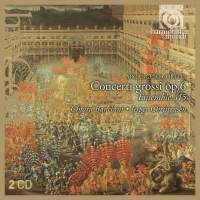Texte paru dans: / Appeared in: |
|
|
Outil de traduction |
|
|
|
|
|
Reviewer: Nils
Anderson One of the modem concepts of Baroque music is that it seems to follow the “less is more“ philosophy. It provides an intimacy and orderliness in our world that is increasingly impersonal and disorderly. Not so. Rather than a particular artistic philosophy, the small ensemble was mostly a matter of limited resources. Given free rein, the eighteenth-century musician was as prone to excess as were those of the nineteenth and twentieth centuries. If, indeed, “excess“ is the proper word. Herewith, the first recorded “big band“ performance of Corelli on original instruments based on contemporary accounts of concerts of his music played in the great homes of Rome. There are thirty-nine (count 'em, 39!) musicians here. The result is an enhancement of the majesty that was always there, and an added weight. The acoustics are, by the size of the ensemble, necessarily farther away, but not distant, and while the result is broad and grand, there is no loss of detail. I've given virtually unqualified praise to Kuijken's and Pinnock's original-instrument performances of Corelli's concerti grossi, but these by Ensemble 415 (the number refers to the lower pitch used during the eighteenth century, as opposed to today's A = 440) are right up there with them. Only the approach is slightly different. Highly recommended. | |
|
|
|
|
|
|
|
Cliquez l'un ou l'autre
bouton pour découvrir bien d'autres critiques de CD |
|




